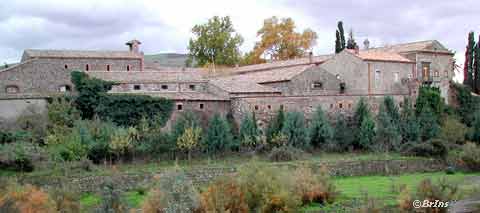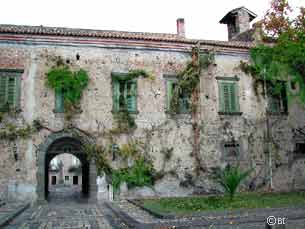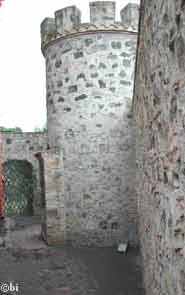An ancient Benedictine Abbey now transformed into a museum
Nelson's Castle  The complex named Nelson Dukedom, is at 13 Km from Bronte, placed on flat land alongside the left bank of the torrent Saraceno. The complex named Nelson Dukedom, is at 13 Km from Bronte, placed on flat land alongside the left bank of the torrent Saraceno.
Comprises the noble wing, once residence of the Nelson, (the Castle) now changed in a Museum, the remains of the ancient Benedictine Abbey, dedicated to the Very Holy Mary, built by Guglielmo II° the Buono, the little church of Holy Mary Of Maniace and a large, very lush park. Was built around the 1173, probably over the ruins of a pre-existent Basilian construction, as wanted by the queen Margherita, in everlasting memory of the victory in battle of Giorgio Maniace against the Saracens. As it was usual at the time, the monastery had a castle or defensive tower. Guglielmo di Blois was the first abbey of the monastery.
The abbey, for the obtained privileges had some considerable income and, as for all feuds, participated to the Royal Curia. In the centuries following the founding went through hard times: was reduced in a miserable state by the "commendatory", (the last "commendable" abbey was the cardinal Rodrigo Borgia, future pope Alessandro VI, "of wicked and inauspicious memory"), all properties were squandered and the unhealthy state of the areas accelerated considerably the depopulation of the nearby farms. At the end of the XV century the abbey, with all his land, became property of The Big and New Hospital of Palermo, until 1799 when was given by Ferdinando III to Admiral Horatio Nelson for having repressed the Neapolitan republic. The earthquake that on 11 January 1693 hit eastern Sicily, destroyed also several parts of the monastery. The seism hit particularly the structures facing east and destroyed the large defense tower adjacent to the church apse, knocking down other dilapidated parts. The Basilian fathers, that conducted the monastery at the time, were forced to leave it and move to Bronte (guest to the church of San Blandano, with permission to build around it a small monastery).  In the new locality, the Benedictine monks brought all their of worship objects, their relics and kept calling themselves "of Santa Maria di Maniace", (their last abbey was Brother Giacomo Cimbali between 1900 and 1904). In the new locality, the Benedictine monks brought all their of worship objects, their relics and kept calling themselves "of Santa Maria di Maniace", (their last abbey was Brother Giacomo Cimbali between 1900 and 1904).
The descendants of Nelson, with disinterest, greed and incredible rapacity, for centuries conditioned the life of the Brontesi generating a quarrel that will drag, with alternating fortunes for the City, until the mid-twentieth century. The restructuring, transformation and enlargement were begun by Horatio Nelson, (he entrusted the task to his first administrator, the gardener Andrea Graefer) who, however, had neither the time nor the good fortune to set foot in the Sicilian possessions and to live in Bronte. In fact, he died in October 1805, a few years after obtaining the title of Duca di Bronte. His heirs, however, and their various administrators, permanently lived until a few decades ago the apartments, gradually transformed into noble residences, now destined to Museum (the first was Charlotte Nelson-Bridport, daughter of the Reverend William Admiral, married to Samuel Hood, viscount of Bridport). Today, of the ancient Benedictine settlement, remains only the Nelson Castle (with the Museum, the garden and the Park), the ruins of the old abbey and the Chiesa di Santa Maria di Maniace. The building complex has become property of the Council of Bronte from the 4th of September 1981; it has been recently restructured with one section used as Museum (the Duke' apartments) and as a center of studies and congress (the old granaries).
The planimetric scheme is the final result of the permanent settling of the Nelson, from 1799 to 1981. The reconstruction, transformation and the enlarging of the ancient abbey to a sumptuous, noble residence was started already by Horatio Nelson, that did not have the time or the luck to ever come to his Sicilian estate or to live in Bronte. His heirs, instead, and their administrators, lived permanently, till few decades ago, in the apartments changed now in Museum, (the first one was Charlotte Nelson-Bridport, daughter of the rev. William, the admiral's brother, married to Samuel Hood, viscount of Bridport). The current plan of the ancient Abbey is the final result of their permanent settlement, which lasted from 1799 to 1981.
 The Dukedom complex The Dukedom complex
is articulated as a ring-like plan with a square perimeter and edifices with one or two floors, lined along outside fronts, that look on the country and on two internal, rectangular courtyard. The all thing, in its simplicity, looks majestic. Two railings lead to the entry arcade and then to the courtyard where there is the lava stone cross erected in memory of Orazio Nelson.
Laterally, to the right, leads to the interesting late-Norman church of Santa Maria and to the square courtyard with a lava stone well, around which, originally were the small workers rooms, the stores, the stables and the granary.
On the first floor, to the left, there were the noble apartments of the Nelson, now used as a museum. Outside the complex can be seen the ruins of two small towers, part of the defensive system of the abbey.
The park A large park, that covers, internally and externally, about four hectares, enriches the Castle.
From the first courtyard it is possible to visit the English garden, wanted by the Nelson: covers about five thousand square meters and enjoys the presence of centuries-old, local and exotic plants (cypress, palms, willow trees, ash trees, horse chestnuts, magnolias), an English green lawn bordered by wisteria, roses, flowers and various plants. Opposite the entry there is a lush park, divided by a central path that, between the majestic plane trees and eucalyptus, holds an open air museum of lava stone sculptures. The park-museum is open to the public and is regularly visited by scholars, students and cultural and tourist operators.
In the park can be seen the ruins of the farmers village, called "Borgo Caracciolo" and built from 1941 to 1944 by the Italian state (the Dukedom had been then seized) and demolished in 1964 by the Nelsonis bulldozers. In the three photos above: a general view of the Nelson Duchy from the Saracena stream that runs alongside its walls; the entrance to the Nelson Dukedom and one of the towers built to defend the ancient Abbey. The word “Castle” can somewhat confuse the visitor as it refers to a seventeen century palace with a solemn, covered portico leading to a courtyard in the centre of a complex dominated by a Celtic style basalt cross. This is the only memento in honor of admiral Nelson with this writing to its base: Eroi Immortali Nili
|